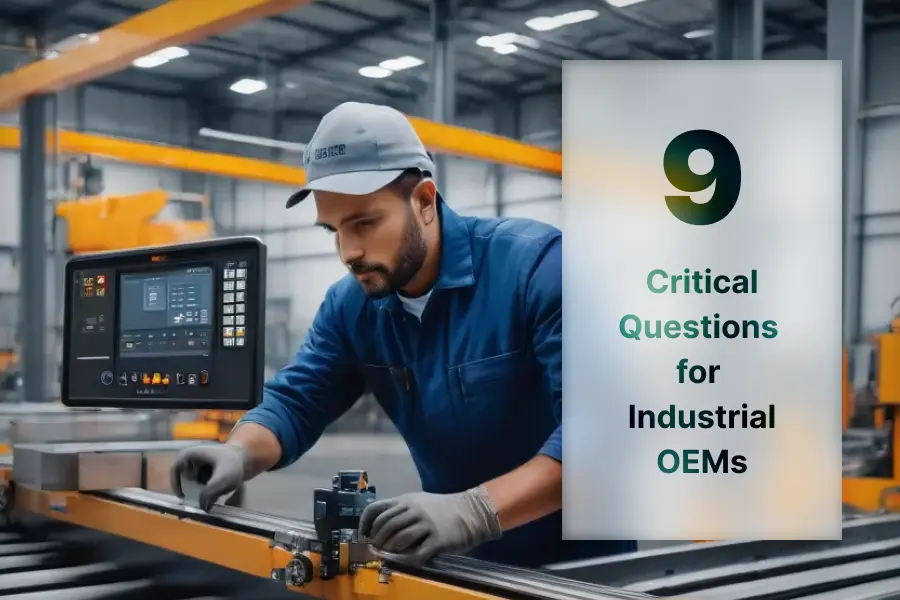
The Industrial Internet of Things (IIoT) has emerged as a transformative force in the manufacturing sector in 2023. And even in 2024, it is all set to promise increased efficiency, predictive maintenance, and data-driven decision-making. For original equipment manufacturers (OEMs), embracing Industrial IoT involves navigating a complex landscape of customization, data utilization, business model transition, and technology adoption.
This blog aims to address nine critical questions that equipment manufacturers should consider as they embark on their Industrial IoT journey.
1. How Does Customization Work for Industrial IoT Applications?
OEMs need the right Industrial IoT solution that can understand and fulfill your unique requirements, as the one-size-fits-all approach may not yield optimal results. However, manufacturers must also navigate challenges such as development costs, integration complexities, and potential burden on employees accustomed to existing systems.
This is where an OEM Enterprise Domain Cloud (OEDC) comes as an alternative. An OEDC allows you to align your Industrial IoT applications with specific workflows, ensuring seamless integration and minimal disruption. Such customized IoT applications offer several advantages, including improved efficiency, reduced downtime, and enhanced data accuracy.
2. What Are the Values of Data Creation?
OEMs can understand the true value of Data as it is at the heart of Industrial IoT. The sheer volume of data by connected devices can be overwhelming, but it also presents a wealth of opportunities. Manufacturers must recognize the value of data not just in quantity but in its potential to inform decision-making and drive strategic initiatives.
Not all data is created equal. Raw data (without proper analysis and interpretation) may not yield meaningful results. So, manufacturers need to invest in tools and technologies that can transform raw data into actionable insights, providing a foundation for informed decision-making.
An OEDC provides you with insightful, real-time data about various parameters like temperature, pressure, humidity, speed, etc., without any hassles.
3. How Much Time Do You Need to Emerge with a New Business Model?
For OEMs, transitioning from traditional business models to Industrial IoT-driven strategies can be a significant change. The journey from conventional manufacturing to IoT-enabled smart manufacturing involves multiple stages. Understanding the step-by-step process is crucial for a smooth business model transition.
Manufacturers need to allocate sufficient time for planning, development, and deployment. Additionally, you may face challenges such as workforce training, technology integration, and potential resistance to change proactively.
However, choosing the right solution can reduce many problems in advance as it takes responsibility for smoothly emerging your business with a new model. They make it easy by understanding your current state and Industrial IoT objectives and developing a roadmap for implementation. You will get valuable time and dedicated resources to implement an IoT-driven business model.
4. How to Deal with Increasing Connected Devices?
Managing an expanding number of connected devices becomes a critical challenge as the Industrial IoT ecosystem grows. It necessitates scalable solutions in industrial settings, like effectively managing and maintaining connected devices for sustained performance. It includes remote monitoring, over-the-air updates, and predictive maintenance strategies. That’s why OEMs need to adopt robust practices, as it can be beneficial to ensure the longevity and reliability of their IoT infrastructure.
Manufacturers must invest in a solution that can accommodate a growing network of devices without compromising performance or security. Choosing the right solution can help you handle an increasing number of connected devices. Platforms that offer easy integration, scalability, and compatibility with diverse devices streamline the management process.
5. What Capabilities Help Us Monitor and Manage Our Equipment?
The ability to monitor and manage equipment in real-time is a cornerstone of Industrial IoT, and IoT-enabled sensors play a crucial role in monitoring equipment health. From temperature and vibration sensors to advanced imaging technologies, manufacturers can leverage a diverse range of sensors to collect real-time equipment performance data.
Predictive maintenance is a game-changer for equipment manufacturers. By analyzing data from sensors and other sources, manufacturers can anticipate equipment failures before they occur, minimizing downtime and reducing maintenance costs.
Real-time analytics provide actionable insights into equipment performance. Manufacturers can make informed decisions based on up-to-the-minute data, optimizing operational efficiency and responding promptly to emerging issues.
6. How Can It Help in Making Informed Decisions and Optimizing Manufacturing Processes?
When Industrial IoT manufacturers have access to accurate and timely data, decision-making becomes more informed and strategic. Optimizing manufacturing processes requires a proactive approach. By leveraging real-time data, manufacturers can identify bottlenecks, streamline workflows, and implement changes that lead to tangible improvements.
Informed decision-making and process optimization are core objectives of Industrial IoT adoption. Measuring the impact of process optimization is essential for gauging the success of IoT adoption.
Manufacturers can quantify benefits such as reduced lead times, increased throughput, and improved resource utilization. Real-world examples illustrate the direct correlation between data-driven optimization and positive outcomes.
7. How Will the Industry Embrace Transformation?
The widespread adoption of Industrial IoT requires industry-wide acceptance and readiness. Not all industries are equally prepared for this adoption. Several challenges hinder, including security concerns, interoperability issues, and the need for standardized protocols. Manufacturers must be aware of these challenges and explore potential OEM enterprise domain cloud (OEDC) solutions to drive industry-wide acceptance.
Analyzing current industry trends and initiatives provides a roadmap for manufacturers looking to embrace the transformation. Whether it’s collaborative efforts, industry standards, or government initiatives, staying abreast of developments in the broader industrial landscape is crucial for informed decision-making.
8. What Is Edge Computing in IIoT?
Edge computing has a pivotal role in the success of Industrial IoT applications. Hence, understanding the concept of edge computing is essential for manufacturers.
Edge computing is a decentralized computing model that brings data processing closer to the data generation source instead of relying on a centralized cloud server.
In traditional cloud-based processing, various devices or sensors send data to a distant cloud server for analysis and processing. This method has inherent latency, as the data must travel over a network to reach the cloud and then back to the end-user device.
On the contrary, edge computing involves processing data locally on or near the device where it gets generated. It decreases the latency associated with data transfer, enhances real-time processing capabilities, and relieves the burden on network bandwidth.
The key distinction lies in the geographical location of data processing. While traditional cloud computing relies on centralized servers often located in distant data centers, edge computing distributes computational tasks across a network of local devices.
Edge devices, such as routers, gateways, or even Industrial IoT devices, process data near where it is produced. This approach is particularly advantageous in scenarios requiring low-latency responses, such as industrial settings, smart cities, and autonomous vehicles, where real-time decision-making is critical. Also, it benefits from bandwidth optimization and enhanced security.
Edge computing thus complements traditional cloud architectures by providing a more efficient and responsive solution for applications that demand rapid data processing at the source. Manufacturers can benefit from processing data closer to the source, especially in environments where real-time responsiveness is critical.
9. How Does OEDC Act as the Best Alternative?
OEM Enterprise Domain Cloud (OEDC) is emerging as a preferred choice for manufacturers implementing Industrial IoT solutions and crucial intermediaries between connected devices and the applications that leverage their data. An OEDC can be an accelerant for OEMs incorporating a SaaS journey at their client level to develop newer revenue streams, and all without investing enormous funds, resources, and time in developing or maintaining the application infrastructure—transitioning an OEM to become a smart OEM.
Manufacturers must assess the features offered by OEDC to define their suitability for their specific needs. It includes considerations such as scalability, security & Data Privacy, application integration capabilities, time to market, total costs, IP ownership, technical debt, and support for diverse devices.
How to Get Started with an OEDC?
An Industrial IoT Adoption requires careful planning and execution. OEMs need to determine and manage potential challenges early in the process, which is essential for success. Manufacturers must consider factors such as security, data privacy, regulatory compliance, and workforce training to ensure a smooth and secure IoT implementation.
Keep in mind that a systematic approach is crucial for a successful Industrial IoT implementation.
Manufacturers can follow a step-by-step guide that includes:
1. Defining Objectives
- Start with identifying the goals and objectives of implementing Industrial IoT in your manufacturing process. It could include improving efficiency, reducing costs, enhancing product quality, or enabling new business models.
- Define key performance indicators (KPIs) to use in measuring the success of the Industrial IoT implementation.
2. Assessing Current Infrastructure
- Evaluate existing infrastructure, including hardware, software, and networking capabilities. Identify any gaps or areas that need improvement to support Industrial IoT integration.
- Consider the scalability of the current infrastructure to accommodate future growth in the number of connected devices and data volume.
3. Selecting the right OEDC Technology Partner
- Research and identify suitable OEDC technology partners. It may involve evaluating technology companies and their products and services in terms of industry expertise and level of competency.
- Consider factors such as reliability, scalability, security features, and the ability to integrate existing systems. For instance, Flex83 is a reliable and versatile solution for seamless Industrial IoT adoption.
4. Developing a Comprehensive Deployment Plan
- Create a detailed deployment plan that outlines the steps and timeline for implementing Industrial IoT in manufacturing.
- Break down the deployment into phases, considering the complexity and criticality of different aspects of the Industrial IoT solution.
- Include contingency plans for potential challenges or setbacks.
5. Ensuring Data Security and Privacy
- Your chosen IoT solution can provide you with robust security criteria to protect Industrial IoT devices, networks, and the data they generate. It includes encryption, secure authentication, and regular security audits.
- Address privacy concerns by establishing policies for data collection, storage, and use, ensuring compliance with relevant regulations.
6. Pilot Testing
- Then, run a pilot test of the Industrial IoT solution in a controlled environment to determine and address any issues before full-scale deployment.
- Reach users and stakeholders for feedback during the pilot phase to make necessary adjustments.
7. Monitoring and Maintenance
- Track the performance of Industrial IoT devices and the overall system by establishing a monitoring system.
- Implement a regular maintenance schedule to address hardware or software updates, security patches, and other necessary improvements.
Conclusion
The Industrial IoT holds immense potential for equipment manufacturers, offering opportunities for customization, data-driven decision-making, and transformative business models. All you need is to choose the right approach to get started on the path of business transformation. In this journey, manufacturers may have a lot of questions related to the complexities of Industrial IoT adoption, unlocking new levels of efficiency, competitiveness, and innovation in the ever-evolving industrial landscape.
Looking for answers to various questions in the way to smart manufacturing is obvious but ensure that your Industrial IoT adoption partner can provide you with great solutions to all your problems without hassle. Only then should you choose them to continue with your journey towards a successful end.
If you have further questions, reach an expert today.

Nishant Puri, CISO at IoT83
Nishant carries professional expertise in team collaboration and network security solutions. He excels at aligning the needs of key business stakeholders, including Sales, Marketing, and Product Engineering, with pragmatic and efficient approaches that meet both short-term and long-term strategic goals.
Before joining IoT83, Nishant held a leadership position at Cisco America Partners, where he led sales and technology solutions. He was also a frequent speaker for Cisco APO, showcasing his knowledge and experience in the field. Being a Cisco-certified Inter-Networking Expert in Security and Collaboration, Nishant brings a wealth of technical expertise to his role. He is also inclined to identify digital discontinuities and is adept at mapping out effective digital transformations.

